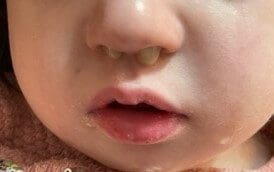
Rhinosinusitis in children
I’m excited. Can you guess why?
Because I am going to write this entire chapter off the top of my head. Rhinosinusitis is an illness (or, more accurately, a condition) that has never been properly explained in any pediatric textbook.
Diagnoses like Streptococcosis and Staphylococcosis (see more below) are conditions that have slowly been disappearing from our study books, leading to increased confusion within the medical community.
On one hand, rhinosinusitis is a legitimate diagnosis, and a good pediatrician is usually able to identify the few children who have this condition. By doing so, they can greatly improve the quality of life of these little patients. However, a pediatrician who is overly enthusiastic about this diagnosis and tends to over-diagnose it may end up over-prescribing antibiotics.
It’s really all about balance—just like everything else in life.
What is rhinosinusitis?
‘Rhino’ = nose and ‘sinus’ = sinuses. These are the same air-filled spaces we all have in our skulls.
Rhinosinusitis is an inflammation or infection that primarily manifests as runny fluids in the nose and sinuses.
Why not just keep it simple and call it sinusitis?
Because in children under the age of 4 or 5, these empty spaces in the skull are not fully developed and ventilated. Therefore, when referring to young children, it is more accurate to use the term rhinosinusitis.
When bacteria settle secondarily in the rhinorrhea (which is usually caused by viral pathogens), they may cause a condition referred to as rhinosinusitis in children and sinusitis in adults.
What kind of bacteria am I talking about? All the bacteria that are part of our normal respiratory flora. One of the less common bacteria is the infamous Streptococcus (and when this occurs, the condition is referred to as Streptococcosis, which often presents more aggressively and is accompanied by fever). Occasionally, Staphylococcus can also be involved (leading to Staphylococcosis, which includes Staphylococcal complications).
Is rhinosinusitis an allergy?
Usually, this condition is not an allergy in younger children. It is typically a viral infection (rhinitis) that has undergone secondary bacterial infection.
In older children, adolescents, and adults, there is a condition referred to as allergic sinusitis.
What are the signs and symptoms of rhinosinusitis?
See the attached image. It shows a child suffering from yellowish/green fluid running from their nose for several weeks. The parents often complain that when they pick them up from daycare, the child always has green boogers in their nostrils.
These are usually children under the age of 5.
These kids also find it difficult to breathe, especially during the night. They cough a lot at night, and their cough often wakes them up from sleep. Poor kiddos.
Often, the skin over their nostrils and nose is irritated and red, and they may also have foul breath.
So, on the one hand, these children are not very sick. They are able to continue going to daycare or kindergarten, and they do not have a fever (if they do, it’s because they also caught a viral infection on top of their rhinosinusitis). On the other hand, they are not 100 percent healthy either.
So, is this sinusitis?
Yes and no.
Yes, because it obviously manifests very similarly to sinusitis.
No, because it happens in young children who do not have fully developed sinuses yet.
Real sinusitis is a condition that affects older children.
How else is pediatric rhinosinusitis characterized?
You know how sometimes children receive antibiotics – for an ear infection (read more here), strep throat (more here), or when pneumonia is suspected (which is not that common in children, read more here)? What I do is, when I take my patient’s medical history, I ask whether the runny nose and general well-being of the child improved when they were started on antibiotics (usually penicillin) for one of the reasons mentioned above. Many families claim that it did, and that, a while after the antibiotics were stopped, the symptoms recurred.
Also, this is a prolonged condition. It does not just last for one or two weeks.
There are no findings upon physical examination beyond the runny nose and the post-nasal drip seen along the back of the child’s throat.
Do the children suffer from a headache as well? It depends. Headache is not a very common symptom in children. And remember, this isn’t classic sinusitis.
What should I be aware of?
Children with one-sided rhinorrhea and foul odor need to see an otolaryngologist as soon as possible to rule out the presence of a foreign object in one of the nostrils. Sometimes, old beads or other small objects are found in the nostrils.
Children with recurrent episodes of rhinosinusitis (or sinusitis in older adults) need to undergo further workup to search for an anatomical anomaly in the area or an immune deficiency.
How is rhinosinusitis treated?
Before we discuss possible treatment options, I think the more important question to ask is: when does treatment need to be considered?
Not all children with a runny nose need to be treated with medication. Not even those who have had a runny nose for a week, crackles overnight, and have visited the office three times already.
The need for medical treatment should be considered in children with typical and prolonged symptoms (at least 3 weeks) and only after having explained the condition to the parents. How should they be treated? Usually, a simple penicillin (for example, amoxicillin) is sufficient. For how long? This is a condition that usually requires a relatively long duration of treatment, approximately 10 days.
In children who have already received many courses of amoxicillin for one reason or another, amoxicillin-clavulanate (600) may be considered (read more about the different types of amoxicillin-clavulanate here).
Is there anything else that needs to be done in addition to antibiotic treatment?
Nasal steroidal sprays may be considered. Despite having said that, in young children, this is not usually an allergic condition. The intent behind steroidal treatment is the reduction of edema, opening up the pores that need to be opened, and allowing the passageway to dry up.
What is the problem with rhinosinusitis?
There are two problems that need to be considered:
1. As I mentioned previously, over-diagnosis. The pediatrician needs to choose those children who he or she thinks will benefit from treatment; otherwise, the pediatrician will find themselves prescribing antibiotics all day, every day.
2. This condition tends to recur in children. I do not know whether this is due to an underlying anatomical condition in these children, but oftentimes, children who receive treatment improve… until they catch the next cold, when all their signs and symptoms return. And obviously, we have no interest in giving multiple courses of antibiotics. It’s annoying. I agree.
To summarize, this is a common medical condition in pediatrics. It cannot be taught in our books, and the pediatrician needs to have good clinical instincts in order to pick out those children who will benefit from treatment.
And when it works, it is wonderful. The child transitions from anaerobic to aerobic breathing, and it is a beautiful scene.
For comments and questions, please register
